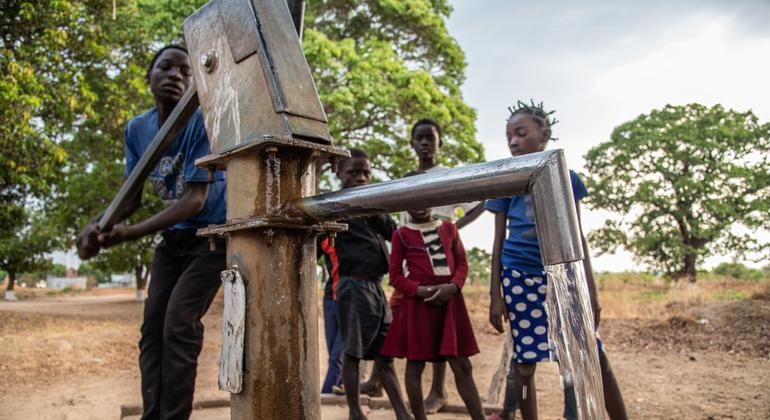Prepare and survive: 5 ways to help countries deal with the climate crisis |

All countries need to make significant cuts to fossil fuel emissions and transition to a low carbon economy, if we are to have any chance of achieving the goal of reducing global temperatures to 1.5 degrees above previous levels. -action.
This continues to be the message from the UN but, with many countries suffering as a result of frequent weather events, threatening food security and global stability, more urgent measures need to be taken, to help the country to adapt to an increasingly hostile world.
Here are five tried and tested ways countries can become more resilient, in the face of climate change.
1 Early Warning systems
Research shows that 24-hour warning of an upcoming heat wave or storm can reduce subsequent damage by 30 percent.. Early warning systems that provide weather forecasts are one of the most effective mitigation measures, yielding around nine dollars of total benefits for every dollar spent.
With timely warnings, people can take early action by barricading doors with sandbags to anticipate floods, pile-ups or, in extreme cases, evacuating their homes.
In Bangladesh, for example, even as climate change worsens, the number of deaths from cyclones has dropped by 100-fold in the past 40 years, largely due to improved early warnings.
But today, a third of the world’s population is still not covered by early warning systems. And while efforts have focused mainly on hurricanes, floods and droughts, other hazards like heat waves and wildfires will need to be better coordinated as they become more common and severe.
Earlier this year, the Secretary-General of the United Nations commissioned the World Meteorological Organization to lead the development of an action plan to ensure that everyone in the world is protected by early warnings within the next five years. The plan will be presented at the UN Climate Change Conference (COP 27) next month.
2 Ecological restoration
The UN Decade on Ecosystem Restoration launched by the UN Environment Program (UNEP) and partners in 2021 triggers a global effort to restore the world’s ecosystems. An international restoration effort will not only absorb carbon but also increase ‘ecosystem services’ to protect the world from its most destructive impacts.
In cities, restoring urban forests cools the air and reduces heat waves. On a normal sunny day, a A single tree provides the same cooling effect as two indoor air conditioners operating for 24 hours..
On the coasts, mangrove forests provide natural sea defenses from hurricanes by reducing the height and power of ocean waves. Also, protecting mangroves is 1,000 times less expensive per kilometer than building seawalls.
At high altitudes, the green mountains protect the areas from the landslides caused by the sun and the sun. For example, in Anjouan Island in the Comoros, deforestation is drying up the land and turning the forest into a desert. With support from UNEP, a project is set to plant 1.4 million trees over four years to slow erosion and retain water and nutrients in the soil.
3 Climate-resilient infrastructure
Climate resilient infrastructure refers to assets and systems such as roads, bridges, and power lines that can withstand shocks from extreme weather effects. Infrastructure is responsible for 88 per cent of the projected costs of adapting to climate change.
A World Bank report found that climate-resilient infrastructure investments in low- and middle-income countries could produce roughly $4.2 trillion in total benefits, around four dollars for each investment. The idea is simple. More resilient infrastructure assets pay for themselves as their lifespan is extended and their services are more reliable.
Tools for encouraging investments in climate resilient infrastructure include regulatory standards such as building codes, spatial planning techniques such as vulnerability maps, and a strong communication drive to ensure that the private sector is aware of climate risks, forecast and uncertainties.
4 Water supplies and protection
The story of climate change is, in many ways, a story about water, be it floods, droughts, rising sea levels, or even wildfires. By 2030, one-in-two people are expected to face severe water scarcity.
Investing in more efficient irrigation will be essential, as agriculture accounts for 70 percent of all freshwater withdrawals worldwide. In urban areas, approximately 100-120 billion cubic meters of water could be saved worldwide by 2030 by reducing leaks. Governments are encouraged to develop comprehensive water management systems, known as Integrated Water Management Systems, that take into account the entire water cycle: from source to distribution, treatment, recycling and back to the environment.
Research shows that investments in rainwater harvesting systems need to be sustained to make them widespread. For example, in the city of Bagamoyo, in Tanzania, rising sea levels and decreasing rainfall are causing wells to dry up and become salty. With no other options, children from the local Kingani School have to drink salt water, leading to headaches, sores, and poor school attendance.
With the support of UNEP, the government began to build a rainwater harvesting system involving roof gutters and a series of large tanks for storing water. Soon the diseases began to subside, and the children returned to school.
5 Long-term planning
Climate adaptation solutions are more effective if integrated into long-term strategies and policies. National Adaptation Plans are an important management framework for countries to plan for the future and prioritize adaptation needs.
An important part of these plans is to examine climate scenarios decades into the future and combine these with vulnerability assessments for different sectors. These can help in planning and guiding government decisions on investment, regulatory and financial policy changes and raising public awareness.
Around 70 countries have developed a National Adaptation Plan, but this number is growing rapidly. UNEP is currently supporting 20 Member States in the development of their plans, which can also be used to improve the adaptation elements in the Nationally Determined Contributions – a central part of the Paris Agreement.







